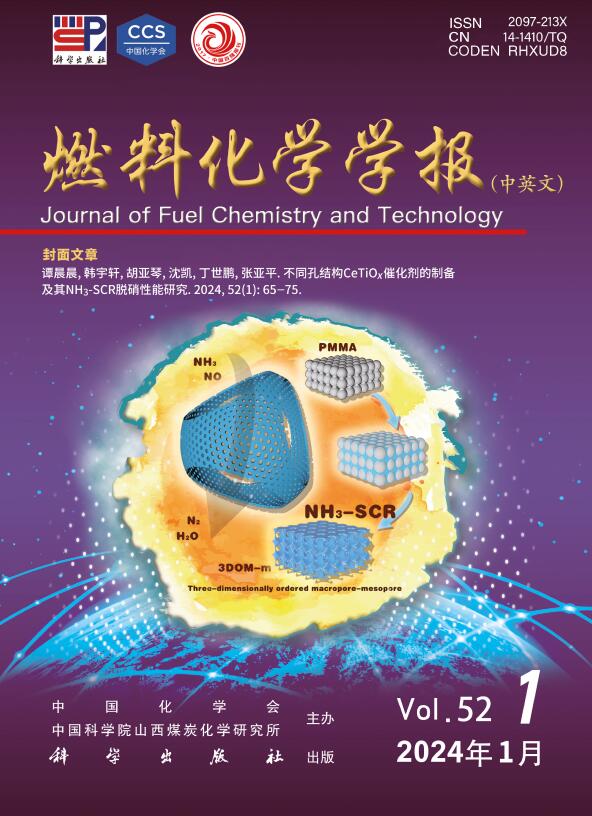The effect of non-free calcium on dissolution-polymerization reaction mechanism of coal gasification slag
Q3 Energy
引用次数: 0
Abstract
Coal gasification slag is an excellent raw material for preparation of cementitious materials. Due to the addition of calcium-based additives, the content of non-free calcium in silicon/aluminum-rich coal gasification slag is relatively high. Thus, the influence of non-free calcium on leaching of elemental and formation mechanisms of cementitious phase were investigated by this paper. The results indicate that non-free calcium primarily disrupts the Al−O−Al bridges in the aluminosilicate glass phase, leading to decreased polymerization degree of slag. The compressive strength of cementitious materials is affected by alkali activation concentration and polymerization degree of slag. Under low-alkali conditions, as the calcium content in the gasification slag increases, the compressive strength of the cementitious material increases firstly and then decreases. Increased calcium promotes leaching of Al, however, large amounts of dissolved calcium tend to form cementitious phases and Ca(OH)2, which can hinder leaching of ions and formation of gel. In high-alkali environments, non-free calcium enhances the compressive strength of cementitious material. Glass phase in slag was destroyed by OH⁻, and leaching rates of Si and Al in slag with high-calcium increase, which lead to more C-A-S-H in cementitious material. Additionally, elevated alkalinity promotes the crystallization of sodium-minerals such as zeolites and sodalite.
非游离钙对煤气化渣溶聚反应机理的影响
煤气化渣是制备胶凝材料的优良原料。由于添加了钙基添加剂,富硅/富铝煤气化渣中的非游离钙含量较高。因此,本文研究了非游离钙对元素浸出的影响及胶凝相的形成机制。结果表明:非游离钙主要破坏铝硅酸盐玻璃相中的Al - O - Al桥,导致熔渣聚合度降低;胶凝材料的抗压强度受碱活化浓度和矿渣聚合程度的影响。低碱条件下,随着气化渣中钙含量的增加,胶凝材料的抗压强度先增大后减小。增加的钙促进Al的浸出,但大量溶解的钙容易形成胶凝相和Ca(OH)2,阻碍离子的浸出和凝胶的形成。在高碱环境下,非游离钙提高了胶凝材料的抗压强度。OH - 9破坏了渣中的玻璃相,高钙渣中Si和Al的浸出率增加,导致胶凝材料中C-A-S-H含量增加。此外,碱度的升高促进了沸石和钠石等钠矿物的结晶。
本文章由计算机程序翻译,如有差异,请以英文原文为准。
求助全文
约1分钟内获得全文
求助全文
来源期刊

燃料化学学报
Chemical Engineering-Chemical Engineering (all)
CiteScore
2.80
自引率
0.00%
发文量
5825
期刊介绍:
Journal of Fuel Chemistry and Technology (Ranliao Huaxue Xuebao) is a Chinese Academy of Sciences(CAS) journal started in 1956, sponsored by the Chinese Chemical Society and the Institute of Coal Chemistry, Chinese Academy of Sciences(CAS). The journal is published bimonthly by Science Press in China and widely distributed in about 20 countries. Journal of Fuel Chemistry and Technology publishes reports of both basic and applied research in the chemistry and chemical engineering of many energy sources, including that involved in the nature, processing and utilization of coal, petroleum, oil shale, natural gas, biomass and synfuels, as well as related subjects of increasing interest such as C1 chemistry, pollutions control and new catalytic materials. Types of publications include original research articles, short communications, research notes and reviews. Both domestic and international contributors are welcome. Manuscripts written in Chinese or English will be accepted. Additional English titles, abstracts and key words should be included in Chinese manuscripts. All manuscripts are subject to critical review by the editorial committee, which is composed of about 10 foreign and 50 Chinese experts in fuel science. Journal of Fuel Chemistry and Technology has been a source of primary research work in fuel chemistry as a Chinese core scientific periodical.
 求助内容:
求助内容: 应助结果提醒方式:
应助结果提醒方式:


